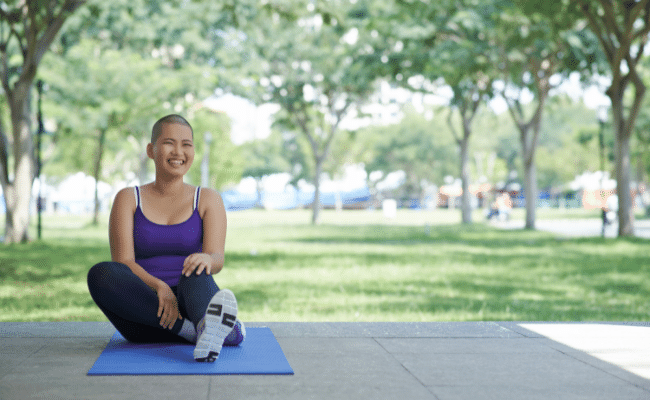
Yoga is a popular yoga for cancer treatment. Studies have found that yoga can help relieve the symptoms of cancer, such as fatigue and depression. Yoga also helps increase energy levels, which is important for people with cancer who are undergoing chemotherapy or radiation treatments. If you’re interested in yoga for cancer treatment, this article will provide you with everything you need to know!
Is yoga good for cancer patients?
The answer may be yes, and the reason why has a lot to do with how stress can contribute to cancer. Some people think that yoga is all about stretching and relaxing. Others think it’s more spiritual than physical. But what if yoga could actually help end some of the suffering caused by cancer?
In recent years, medical researchers have zeroed in on chronic stress as an important contributor to cancer risk and prognosis. Cancer patients are stressed out for many reasons, not least being concerned about their financial security while they’re ill. Other stressful factors include fear of death, concerns about whether they can maintain relationships with family members and friends who care for them emotionally or provide them tangible support like childcare during treatment or visiting hours at a cancer clinic.
Fortunately, there’s emerging evidence that yoga may combat these effects of stress on cancer cells. One study published in Medicine & Science in Sports & Exercise found that women who did yoga regularly had lower levels of self-reported stress than those who didn’t practice yoga at all or participated in other exercise activities instead.
These lower stress levels were associated with reduced blood pressure—and evidence suggests that reducing blood pressure is important for cancer prevention. Another study compared the effects of yoga with those of a conventional exercise program on breast cancer survivors and found that breast self-exams (BSE) improved equally in both groups—but only among women who did not practice yoga.
In fact, total BSE scores were significantly lower among women who practised yoga than their non-yoga peers. It’s possible that the mental relaxation offered by yoga fosters deep physical relaxation as well. A study published in Complementary Therapies in Medicine found that meditation, including mindfulness techniques common in many types of yoga, was associated with decreased pain perception and less fatigue after chemotherapy treatment.
Is yoga good for breast cancer?
A recent study in California looked at breast cancer survivors who practice yoga. For the study, researchers followed 150 women with early-stage breast cancer for a year to see how they responded to yoga along with their usual medical treatment compared with three other groups. Those who got usual care only, those who got medical treatment and took part in physical activity such as walking or resistance training, and those who got both types of interventions.
The team found that the women in the third group experienced greater improvements in physical function — like walking long distances without getting breathless — than did either of the other two groups. Yoga also reduced side effects from treatment among many patients, including fatigue, insomnia, and depression.
The researchers are hopeful that yoga can improve the quality of life for breast cancer survivors, especially those in remission who have completed cancer treatment but still report fatigue or insomnia as a result of this illness.

Is yoga cure cancer?
The answer is yes and no. Yoga can cure cancer but not all the time. It depends on the type of yoga you do and how long you practice it. people have been practising different types of yoga for thousands of years now to cure many ailments including cancer.
Yoga in minutes brings a dramatic change in your body by relaxing your muscles and giving more oxygen supply to the brain as well as other vital organs throughout the body. This helps decrease anxiety levels, depression and cures insomnia since more oxygen reaches different parts of your body promoting better sleep patterns at night which also has a positive impact on dealing with cancer or any related illness.
If done regularly along with a healthy diet, meditation techniques followed daily will help your body cope with cancer in a better way. Like other elements such as diet, meditation, and a healthy lifestyle also plays a key factor in overcoming cancer by stimulating your immune system to work more efficiently and naturally slowing down the proliferation rate of cancer cells.
Yoga offers many benefits like improved energy levels, emotional strength, decreased pain tolerance thresholds thereby delaying any kind of side effects linked to chemotherapy or radiation therapy allowing you to continue your treatment without much stress or pressure on the mental front from day-to-day life. Be it breast cancer, cervical cancer or colon cancer which affects millions around the world including men yoga is something that should be practised daily even when one is not diagnosed with any kind of disease so as to ward off any potential future problems linked to the immune system.
For example, regular yoga can reduce a woman’s risk of developing breast cancer by as much as 44 percent according to one study in 2011, which also discovered that practicing yoga for just two hours a week has a 55% lower mortality rate than women who practiced it less than once a month.
Benefits of yoga for Cancer Patients:
Practicing yoga for cancer patients can help their recovery and relieve many of the side effects often associated with conventional medicine.
Yoga for cancer helps in the following ways:
- Reduces Pain
- Treats Depression
- Builds Self Confidence
- Improves Vision
Reduces Pain:
Yoga reduces pain by increasing blood circulation to painful areas. Other than this, there are also other benefits like deep relaxation that helps you feel better and reduce stress levels which have a proven ability to make us more resilient when it comes to dealing with pain. Regularly practicing yoga for cancer, especially restorative asanas such as Child pose (Balasana) will do wonders in helping our body relax without harming or causing any harm to ourselves.
As yoga does not involve vigorous movements, both beginners, as well as advanced practitioners, will find them very beneficial in reducing pain and achieving healing. This is because restorative asanas are designed to help the affected area in achieving total relief from pain and stress.
Treats Depression:
Many cancer patients suffer from depression which has a depleting impact on their immune system, making them more susceptible to infection and other problems related to immunity.
Practicing yoga for cancer helps our mind relax and be at ease with itself. It also gives us an opportunity to step out of ourselves. when doing pranayama exercises (breathing exercise) which focuses on breathing patterns connected with respiration, rhythmic movement in different parts of the body, and certain setup forms of physical postures/asanas that help the practitioner gain insight into his own self – consciousness. Yoga teaches us about our body and how we should take care of it.
Builds Self Confidence:
Yoga teaches us how to stay in shape even when the body resists intense physical exertion like breathing exercises that involves holding the breath for a long time, developing the concentration needed during pranayama exercise, etc., all of which helps yoga practitioners reduce their stress levels and be at peace with themselves.
As mentioned earlier, yoga for cancer also helps us develop self-confidence by increasing our immunity thus helping us fight infections caused by stress or negative emotions such as sadness or frustration. This is because yoga calms the mind by teaching each individual to meditate on his/her own self-consciousness.
Improves Vision:
One of my friends who was diagnosed with breast cancer a few years ago suffers from low vision due to the side effects of the medicine. She was very scared that she might end up losing her sight completely as it had happened to another friend who is now blind.
My friend decided to take yoga classes in hopes of improving her vision, as she had heard about its benefits for eyesight and overall health, especially for cancer patients. After a few months, she was able to reduce her medicine. Today, she can read a few lines on the chart. She is now able to move around and do some chores at home and at work. This shows that yoga for cancer can help improve vision by reducing stress levels brought about by rejection from society or simple frustration in being unable to see clearly, which caused her depression thus increasing her medicine intake.
Is hot yoga good for cancer patients?
Hot yoga for cancer is claimed to be good for cancer patients because it:
1) Increased circulation does not necessarily improve breathlessness and fatigue in those with advanced cancer. It may even cause harm by causing hypotension, or dangerously low blood pressure; this is more likely to occur when people with advanced disease are treated with drugs that increase the risk of hypotension.
2) Increased sweating is a natural response to heat stress, and it does not necessarily lead to detoxification (I will explain this point further down).
3) Endorphins are naturally produced in the body (and also released during exercise), and thus doing something else besides hot yoga – such as going for a walk – would still produce endorphins.
4) hot yoga for cancer may actually be harmful to people with cancer because there is danger in exposing them to temperatures that exceed body heat production; these excessive temperatures may cause hyperthermia. Excessive sweating from hot yoga for cancer has led some practitioners to develop serious infections, including pneumonia or sepsis, or even to die of hyperthermia.
Is yoga good for liver cancer?
Yes, it is! Yoga for liver cancer can be great if you have a calm and focused mind. Even if the yoga poses are physically challenging, the balance of your mind will really help you to feel better both in your body and within yourself emotionally. Liver disease can lead to cirrhosis or cancer of the liver which occurs when abnormal cells grow out of control. The liver is responsible to break down harmful toxins and removing them from our bodies via bile excretion.
When this happens, we see symptoms like upper right abdominal pain, loss of appetite, weakness, nausea illnesses such as hepatitis B or C (both viruses) that cause chronic hepatitis inflammation which leads to scarring called cirrhosis that slowly destroys the tissue and organs within the liver.
When a patient with liver disease begins to practice yoga for cancer, it will help them focus and gain control of their minds which then leads us to the next step: emotional healing. Focusing on poses that are physical such as inversions or basic hip-opening poses can be a great place to start. Bikram yoga for cancer also helps because it enforces deep breathing which is very beneficial for your body, and especially beneficial during cancer treatments (chemotherapy/radiation).
Specifically, this pose called The Cobbler Pose or Baddha Konasana is good for liver issues. It stretches out the lower back while strengthening your quadriceps muscles so you get relief from lower back pain as well as lessen the load on your knees when performing Viralasana (Child’s Pose).

Is yoga good for lung cancer patients?
September 20, 2006 — A small but encouraging study shows that yoga breathing and relaxation techniques may improve the quality of life for lung cancer patients. The study’s results were published in today’s issue of Cancer, a journal of the American Cancer Society. More than 2 million Americans have been diagnosed with lung cancer, and it is the leading cause of cancer death in both men and women.
Fewer than one-third survive for five years after a diagnosis, according to the article. Cancer patients may live longer if they participate in special rehabilitation programs that might include yoga breathing techniques — specifically alternate nostril breathing — relaxation exercises and meditation.
The study included 49 people with newly diagnosed lung cancer who were undergoing chemotherapy at Henry Ford Hospital in Detroit between 1998 and 2002. The participants performed a series of 15 yoga exercises three times per week over six weeks. In addition, 20 healthy volunteers without lung cancer received the same training regimen so researchers could assess how much benefit was being derived from simply participating in the study.
After six weeks, the lung cancer patients who performed yoga exercises reported a significant improvement in quality of life compared with their own condition at the start of the study. They also had better scores on measures of mood disturbance, fatigue, concentration, and overall functioning than healthy volunteers who did not perform yoga breathing techniques.
In addition, participants’ physical endurance increased significantly by the end of therapy and remained high until week 10 after treatment ended. The positive results lasted for four months after completing treatment.
Chair yoga for cancer patients:
The low-stress approach of chair yoga for cancer can assist people in feeling better and doing everyday activities while they are fighting cancer. It can be done from home and may also be a gentler approach for people who do not feel well or are fatigued. It is done in a seated position so that participants need not worry about balance, fatigue, stress on bones and joints, or any fear of falling.
The benefits of chair yoga for cancer patients include:
- Helps to reduce the side effects of chemotherapy such as nausea, vomiting.
- Loss of appetite and fatigue
- Helps survivors regain confidence after the surgery
- Encourages improved sleep quality
- Reduces back pain caused by sitting too much during treatment and daily activities.






